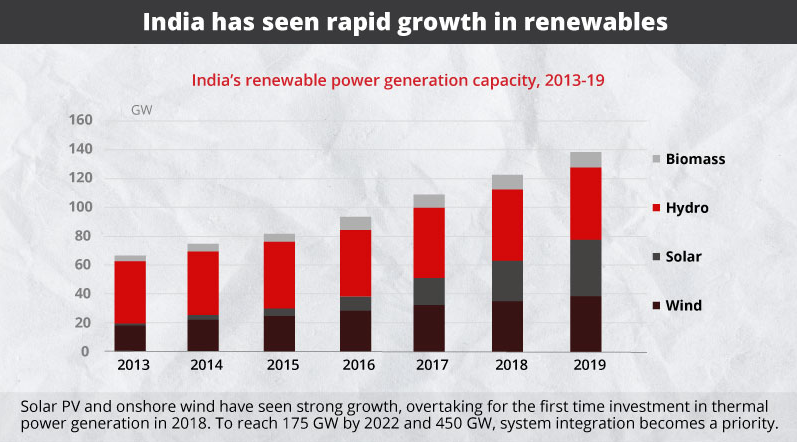One Sun One World One Grid
This article is based on “Global solar grid could cause sun burns” which was published in The Financial Express on 25/06/2020. It talks about the challenges associated with the concept of One Sun One World One Grid.
In recent years, India has leveraged forums like the G20 and the UNFCCC to collaborate with major powers in new areas of growth and in bringing about global reforms. One such initiative is One Sun One World One Grid’ (OSOWOG).
Under OSOWOG vision, India seeks to replicate its global solar leadership (International Solar Alliance) by encouraging the phased development of a single globally connected solar electricity grid to leverage the multiple benefits (Low cost, Zero pollution) of solar energy.
The underlying logic behind OSOWOG is that a grid spread across multiple time zones could balance intermittent renewables with other renewables: the setting sun in one part of the grid is made up for by solar, wind or hydropower produced in a distant place.
OSOWOG seems to be a brilliant idea in pursuit of sustainable development.However, it faces certain challenges in its implementation.
Prospects For India
- Parity with Great Powers: This ambition puts India alongside other major powers and their super-grid projects such as China’s Global Energy Interconnection project, Europe’s gold-standard power pools.
- Also, OSOWOG will provide an opportunity for India to move onto the centre stage globally, accelerating the energy system decarbonisation to help solve the global climate crisis.
- Climate Mitigation: OSOWOG assumes more importance in backdrop of the USA’s withdrawal from the Paris climate deal.
- Also, OSOWOG will help to mitigate ill effects on climate by providing clean and renewable energy sources.
- Further, enabling member countries to fulfill their Nationally Determined Contributions (NDCs) towards reducing global warming.
- Balancing China: OSOWOG will provide a strategic rebalance in favour of India and will control the increasing Chinese dominance in Asian subcontinent, providing a better alternative to developing countries.
- Bridging Current Account Deficit: India is currently importing around $250 billion of fossil fuel annually (oil, diesel, LNG, coking and thermal coal).
- OSOWOG can help India meet its needs and subsequently promote sustainable renewable energy exports and may improve the current account deficit and reduce imported inflation pressures.
Issues with the Idea
- Development in Battery Technology: With development in electricity storage technologies, reduces the viability of the need to follow the sun along any latitude, nor worry about day and night.
- Easy Installation of Microgrids: Large capital expenditures are no longer necessary, as anyone can install rooftop solar or set up a microgrid (“distributed generation”).
- Vulnerability of Grids: Electricity Grid is vulnerable to accidents, weather, and cyber-attacks that are prone to increase and disrupt the electricity supply on mass scale.
- Transmission Losses: Solar generation is at less than 20% efficiency, in addition there will be major transmission losses on such scale.
- Dependency on China: India is dependent on Chinese imports for solar equipment, such as solar cells, panels, etc.
- Problem with Interconnectedness: This project’s success hinges on trust, not just transmission lines, between grid participants.
- Interconnected grids give countries the power to bring other economies to a grinding halt; this is the single biggest hurdle to integration.
Way Forward
- Creation of Supranational Rule-Based Organisation: Institution building is key to fulfilling the ambitions of a multi-country grid project.
- In this context, ISA can act as an independent supranational institution to take decisions about how the grid should be run and conflicts settled.
- Promoting MicroGrids: Along with prioritizing designing microgrids, public policy attention is needed for developing battery technologies at scale for local applications.
- Constructively Engaging with China: Given India’s dependence on Chinese imports, OSOWOG will have to find ways of engaging with Chinese ambitions in a constructive manner rather than in a zero-sum way.
- Also, there is a pressing need to build its domestic capacity in solar equipment under the Make in India program.
Establishing a global solar grid is a novel idea, especially in context of climate change. However, underlying issues in its implementation needs to be addressed first. Apart from it, India can explore the possibility of establishing a federation of regional grids like SAARC grid.
|
Drishti Mains Answer “One Sun One World One Grid seems to be a brilliant idea in pursuit of sustainable development, but faces certain challenges in its implementation.” Discuss the feasibility of this idea. |
This editorial is based on “Bad to Worse” which was published on The Hindu on June 25th, 2020. Now watch this on our Youtube channel.

